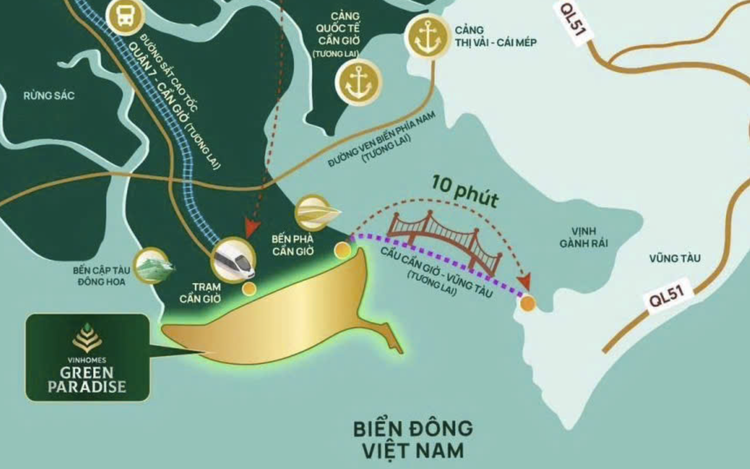
Vingroup has proposed building a sea-crossing bridge to connect Can Gio and Vung Tau in Ho Chi Minh City.
The proposal, submitted to the Ho Chi Minh City People’s Committee, suggests the project be developed under a build-transfer (BT) model.
The group said that the proposal aligns with the prime minister’s Decision No. 1125, issued on June 11, which approved adjustments to Ho Chi Minh City’s master plan through 2040 with a vision toward 2060.
The plan prioritizes modern transportation infrastructure and regional connectivity as key strategic goals.
Following the administrative merger of former Ba Ria - Vung Tau Province and former Binh Duong Province into Ho Chi Minh City, effective from July 1, the need for a direct coastal link has become increasingly urgent, according to the group.
The Can Gio - Vung Tau corridor holds strategic significance for Vietnam’s maritime economy, tourism industry, and ecological urban development.
However, the city’s transport infrastructure remains underdeveloped, relying heavily on ferries and long detour routes.
A sea bridge, or similar elevated coastal route, would reduce travel time between the two coastal areas and create a new transport axis connecting various functional zones within the expanded city.
The project is expected to unlock economic, social, tourism, and urban development opportunities along the southern coastal corridor.
“Vingroup respectfully proposes that the Ho Chi Minh City People’s Committee grant approval to research the investment in the Can Gio – former Ba Ria-Vung Tau sea bridge project under the BT model," the firm stated in its proposal.
“This proposal represents an initial step toward assessing feasibility and establishing a legal basis for subsequent stages."
Vingroup also emphasized its commitment to supporting the city in implementing critical infrastructure projects, contributing to enhanced regional connectivity and the sustainable development of the coastal zone.
This latest proposal follows Vingroup’s groundbreaking of the Can Gio coastal tourism urban area on April 19.
Spanning 2,870 hectares and designed to accommodate nearly 230,000 residents, the world-class project marked a turning point for Can Gio, a once-isolated area with limited road access.
The area is now poised to become a new urban gateway and economic hub for Ho Chi Minh City during the 2025-30 term.
Several other major infrastructure projects are underway or under consideration in the area.
These include the ongoing land reclamation project, the Rung Sac interchange connecting to Ben Luc - Long Thanh Expressway, Can Gio Bridge, a high-speed rail line, and the broader coastal road network.
The municipal Department of Construction had previously studied a southern coastal route through Ho Chi Minh City, intended to link the Mekong Delta’s coastal road system with the former Ba Ria-Vung Tau Province.
This included a branch route for a potential sea bridge connecting Can Gio to Vung Tau.
Under the national road network development plan for 2021-30 with a vision to 2050, the prime minister identified coastal routes as a priority for local transport development.
The southern coastal corridor, including its segment through Ho Chi Minh City, was emphasized as a key part of this vision.
The government leader urged local authorities to review and align their planning and project development efforts to ensure consistency with the national transportation strategy.


Max: 1500 characters
There are no comments yet. Be the first to comment.